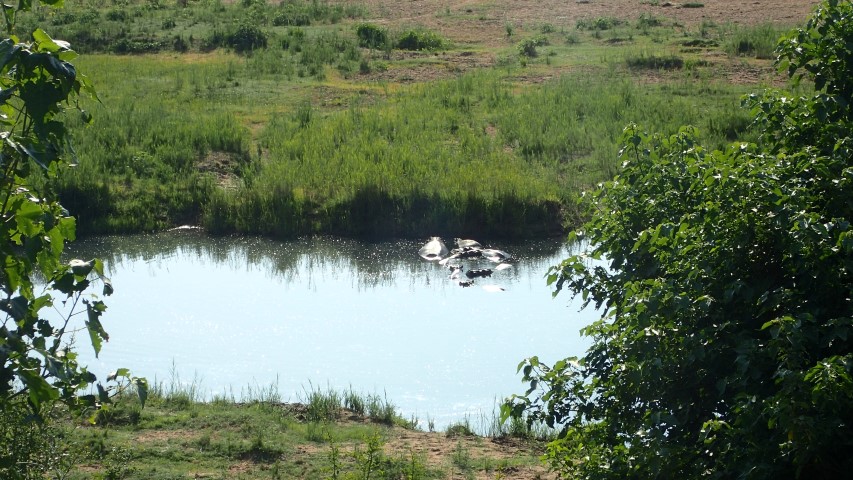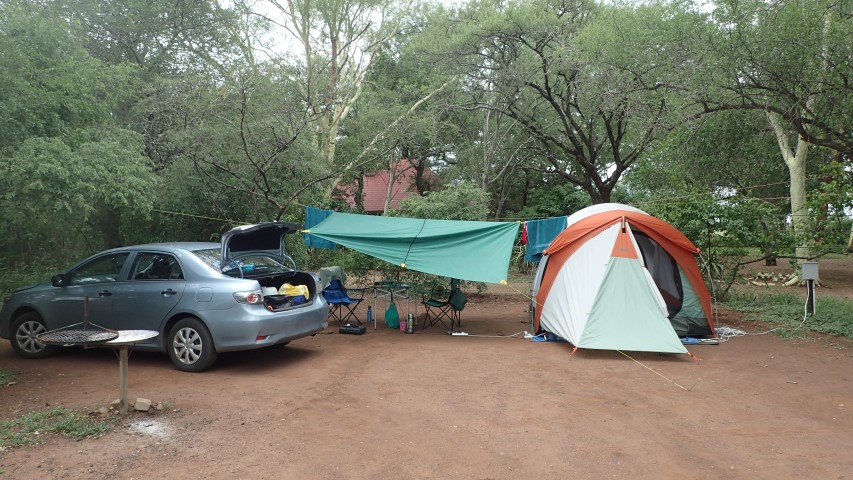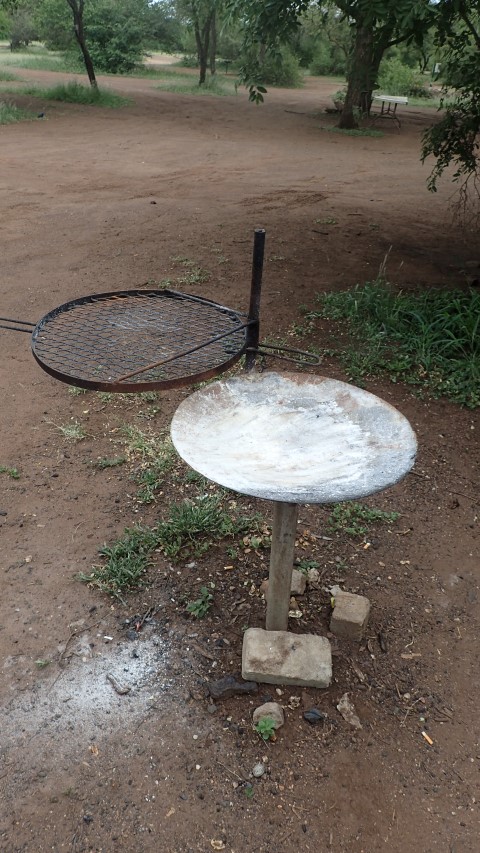Wildlife tally for Sunday Feb 1
We’ve learnt some new words for describing groups of animals, and couldn’t wait to show off our improved vocabulary. There’s a good list here
Here’s what we saw yesterday.
dazzles of zebras
a couple of herds or parades of elephants
a bloat of hippopotamus
a tower of giraffes
impala
bushbuck
waterbuck
common reedbuck
a leopard tortoise
New to our list today – lots of banded mongoose including many babies and an implausibility of blue wildebeest.
My favourite group description is a ‘dazzle of zebras’, Greg’s is ‘an implausibility of wildebeest’. I’m really hoping to see a crash of rhinos while we’re here. Greg has added more photos to our last post, Out & about in Northern Kruger National Park, including a better pic of the crocs with the dead hippo, so you can play ‘Spot the Crocs’.
We have been befriended by a Southern red-billed hornbill. He has fallen in love with our car, or rather, his reflection of himself in the car’s windscreen. He’s quite tame, very persistent, quite vocal and I reckon if Greg spent enough time with him, he’d be able to teach him how to count to 10 by the time we leave.
Our friend Margaret commented that she hadn’t realised that Kruger National Park was so popular. Here’s a bit more info about it:
Around 19,500 square kms, covering 350km north-south and 60km east-west. The entire eastern boundary forms the border with Mozambique, and with Zimbabwe along the Limpopo River to the north. Along the western edge are several large privately owned game reserves, most (if not all) of which offer upmarket accommodation and wildlife experiences. We’re not upmarket enough with our tent, so we’ll stick to staying in some of the 26 (!!!) campgrounds in Kruger, which are able to provide accommodation for over 4000 people per night. We moved to the Satara Rest Camp this afternoon, which is in the Central part of Kruger. There are 3 guesthouses here, 180 self-contained units and a 600-site campground. And there are a couple of even larger campgrounds further south!
It hasn’t been busy anywhere we’ve stayed or driven, but during the summer and other school holidays, I’m sure it would be packed. It’s only a few hundred kms from Joburg and Pretoria and South Africans do love the outdoors. I think they are even keener barbecuers than Australians, if that’s possible. They call a barbecue a ‘braai’ – rhymes with ‘dry’ – and have all sorts of braai utensils and equipment that we’ve never seen before. We bought a beautiful cast-iron bread tin with lid (like this one here) that I’m looking forward to using when we go outback camping at home. A braai is standard in all campsites – it might be a half 44-gallon drum on its side, some kind of large dish to hold coals with a grill above it or even just a concrete area to light a fire on. There is always something so that people can cook outside … and they do!



Thank you for explaining about the size of the Kruger Park Judy and what camp sites there are . I don’t have a lot of knowledge about South Africa. Very interested in the names of groups of animals . I hope to remember some as these come up in my favourite TV quiz program
called POINTLESS. Which comes on at 5-15 every afternoon when it’s my time to sit and relax with a Latte . Enjoy your day and I think you are so lucky to see animals in their natural habitat.x
I agree about the animal names, some of them are just perfect for the animal they are describing. I love trivia like that, & we love going to Quiz nights, so long as there aren’t too many sport questions. xx
Love all the animal names and wonder where some of them came from, some are obvious and others are a mystery. Good quiz questions and answers among them.
Char, I feel like I should take up doing crosswords or word puzzles with my new knowledge! xx
Satara is ancient Persian for star (Farsi). It was my choice for a name for Maisy actually. Interesting how far words travel also. Pictures are great!
That’s interesting, Grant. In this case, it was a misspelling of ‘satrah’, meaning seventeen, the name given to this farm by the land surveyor and his Indian assistant in the late 1800s. It was never used for farming, but in the early 1900s became a ranger’s post, and the tourist camp was added in the late 1920s.
I’m the same . I had no idea the size of Kruger .I thought it’d be like Dubbo Zoo !
The only animal grouping I know is … a gaggle of geese . So I’m learning lots and loving your BLOG ! x
I’ve gotta admit, I hadn’t realised it was as big as it is until we got here. It’s divided into 4 regions (Far North, North, Central and South) across 2 provinces. Each has its own micro-climate, geology and certain flora and fauna groups favour one region or another. For example, lions and rhino are more prolific in the south than further north.
Sal, I’ve found HEAPS of marula trees! They are planted all around the swimming pool here, and the fruit has been raked into a pile. I wonder if someone is planning on making some liqueur with them. They seem to fall off the trees unripe, then ripen on the ground. They smell sweet, like the liqueur, but not fermented …yet! And here’s the Wikipedia article on them
Really interesting Jude . Have you eaten one ? It certainly is a beautiful tree ! x
No, I haven’t eaten one, Sal. I don’t like most fruit, so haven’t felt at all tempted. It looks a lot like an apricot.
People this does seem quite some holiday if this is there summer why is everything so green or are there temp not as hot as ours you went see wild life and you are sure getting a good covering of that as for extra names will give them a miss Greg yesterdays bush fire was nowhere near you place .
I was surprised at how green everything was when we were in Joburg, Ron, but I’ve got used to it now. Seems like it doesn’t get as hot here, and it rains more in summer. When we were in Botswana, the locals complained when it was 34C, and looked amazed when I told them that it got up to 47C where we came from. At the moment it’s 20C and Greg is complaining about the cold!
It is pretty tropical here. Most of Krugers rain comes in the summer. The average rainfall for February is 120mm . We also noticed that there is no sign of fires in the “bushveld”. It just never gets dry enough for a fire.
I’ve just caught up with your blog, as I didn’t read for a few days. I’m positively all nostalgic – Africa is a world apart although I never experienced a tent during my years there!! By the way, avoid Amarula eating elephants – the amarula lies on the ground, starts to ferment, the elephants eat it and it gives them a shocking hangover…….
Ah, thanks for clearing up the Amarula questions, Hazel. Did you ever have any ‘homebrewed’ versions while you were in Kenya? Glad you’re travelling with us xx
No, never had Amarula but had ‘pombe’ a number of times – the first time drunk from a kudu horn at a wedding…….and handed round the circle of African men seated on the ground.